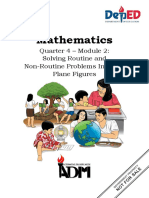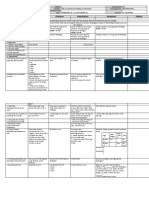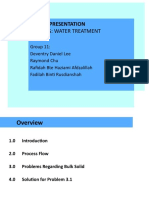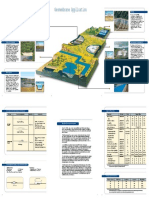4 A's DLP Sample
4 A's DLP Sample
Uploaded by
Jake AlojadoCopyright:
Available Formats
4 A's DLP Sample
4 A's DLP Sample
Uploaded by
Jake AlojadoOriginal Description:
Copyright
Available Formats
Share this document
Did you find this document useful?
Is this content inappropriate?
Copyright:
Available Formats
4 A's DLP Sample
4 A's DLP Sample
Uploaded by
Jake AlojadoCopyright:
Available Formats
School Antipas National High School Grade Level Grade 8
Daily Lesson
Teacher Leyric S. Biogos Learning Area T.L.E. 8- Agricrop
Plan
Date January 27, 2022 Quarter 2
I. OBJECTIVES At the end of the lesson, the learners will be able to:
1. Discuss the factors to be considered in Layouting a crop farm
2. Appreciate the importance of each factor.
3. Draw a crop farm considering all the factors of layouting.
I. SUBJECT MATTER
Topic Factors in Layouting a Crop Farm
Materials Laptop, Activity Sheets,Paper
Reference SLM T.L.E. 8- Agricultural Crop Production Q2-M3
II. PROCEDURE
Preparatory Activities a. Prayer
b. Greetings
c. Checking of Attendance
d. Review
Developmental Activities
a. Presentation The teacher will present the topic and the learning objectives to the class.
b. Activity Group Activity
The teacher will divide the students into 5 groups to do the activity presented
below.
Direction: Answer what is asked in GIVE ME WHAT I WANT column. Look for
your answers under the QUANTITY column and note the corresponding LETTER
CODE and WORD to complete the grid and to answer the given question.
ITEM GIVE ME WHAT I WANT
1 Surface area of rhombus whose base is
3cm and height of 2cm.
2 Number of square meters in 1ha.?
3 Surface area of the square with side 10m.
4 Number of cm2 in a rectangle with the
dimensions 20m x 12m.
5 Surface area of a triangle with a base
20cm and a height of 10cm.
6 Volume of a cube whose side is 7cm.
QUANTITY LETTER WORD WORD
6 cm2 L You
2
100 m Y Such
100 cm2 U Amazing
240 m2 O An
343 cm3 T Kid
10000 m2 A Are
Now, complete the grid by writing the LETTER CODE in the boxes
on the first row and the WORD on the second row that
corresponds to your answer. The letters and the words you
correctly formed answer the questions below.
It refers to fixing the position of
plant in an orchard.
What is the message of this activity
using the WORDS you correctly
arranged?
ITEM NUMBER 1 2 3 4 5 6
Scoring Rubrics:
5 3 1
Cooperation Each member of Some member of the No cooperation from
the group group did not the members of the
participates in cooperate group.
the given task
Presented Answer The group got all The group presented Incorrect answer
the correct some correct answer
answer. but missed a few
parts.
Time Finished the task Finished the task Did not finish the
within a given more than the given task.
period of time period of time.
c. Analysis The teacher will ask the following questions to the students.
1. What can say to the activity this morning?
2. Is there any difficulties you encountered during the activity?
3. Have you noticed the word “LAYOUT” from our activity?
4. What do you think is the connection of that word from our topic?
d. Abstraction To determine if what is the main topic of the day, the teacher will ask the following questions:
1. What are the factors to consider in Layouting a crop farm?
2. Is it necessary for us to appreciate and consider the importance of
each factors in layouting a crop farm?
Answer:
FACTORS TO CONSIDER IN LAYOUTING A CROP FARM
1. Site Selection- The selection of sites is important. The north-
easterly slopes are preferred for maximum sunlight,
warmth and wind protection. Slopes are prone to erosion,
and must be carefully
grown. Do not grow vegetables on slopes greater than seven
degrees (7 °) to avoid soil erosion and the silting of
waterways.
2. Considering Buffer Zones- Buffer
zones are areas of vegetated land
that need to be set up or left in place to protect vulnerable
parts of the landscape and provide a wildlife habitat or
sanctuary. They should be situated between the area of
farm operation and any areas that may affect or
contaminate water quality. Water surroundings, or security
features, are:
a. Riparian areas include flood plains adjacent to rivers and
streams, as well as other waterways.
b. Wetlands (Areas of land which are either temporarily or
permanently covered by shallow water and play a
crucial role in the recycling of nutrients) Wetlands are
highly ecologically productive, and should not be
drained, filled, or used as storage.
c. Drainage lines looking out for your run. Leave at
least 20 m for small streams and 50–100 m for
rivers such as the Hawkesbury – Nepean, a strip of
unclear native vegetation between the top of the
bank and your farming activities. This buffer zone
intercepts and filters run-off of chemicals and
nutrients from farms.
3. Soil types- Soil types must be suitable to the crop being
cultivated. Deep, well drained sands, sandy loams, and
loams are the better types of soil. Heavy clays are much
less suitable as they drain poorly and are easily
waterlogged.
4. Groundwater contamination- Search for pollution from
groundwater. Pollutant pollution of the groundwater will
impact your farm operations. Although welldrained soils
are preferred for growing vegetables, there is a greater risk
that pesticides, herbicides, and fertilizers can leach
through them and contaminate groundwater resources.
5. Windbreaks- Wind safety and screening is recommended for
the whole farm as well as individual large paddocks.
Property screening, particularly with trees, prevents many
complaints about agricultural activities. Windbreaks often
avoid water, dust, bugs, and noise from blowing and
spreading into surrounding areas.
6. Soil management- You need to plan your soil management
strategies. It is important to provide good drainage and
install grassed drainage/ waterways in conjunction with
fields.
7. Water management- Water supplies must be able to meet the
needs of crops in periods of drought when water demand is
high. Water quality is also important. Poor water quality
reduces the
growth and yield of crops.
*It is necessary to appreciate and consider the importance of each factors in
layouting a crop farm because these will help us best to achieve our ultimate
goal in farming which is to have a great production of crops.
e. Application The students will now apply all those things they learned from the
discussion.
Aim High and Hit the Mark!
Direction: For 15 minutes, Draw your future crop farm considering all those
factors in Layouting a crop farm. Draw it on a short- sized bond paper. Make
some labelling.
IV. EVALUATION Multiple Choice: Write the letter of the correct answer in a ¼ sheet of paper.
1. An area of land that is permanently covered by a shallow water is ____?
a. Wetland b. Riparian c. Buffer Zone d. River
2. The following are factors of layouting a crop farm, except?
a. Site Selection c. Soil Type
b. Soil Management d. Measuring Area
3. It is not advisable to plant vegetables on slopes greater than 7 o for the
reason of it is____________.
a. Prone to soil erosion and silting of water ways
b. Prone to flood
c. Prone to water contamination
d. Prone to droughtness
4. Poor water quality _______ the growth and yield of crop.
a. Increases b. Raises c. reduces d. refresh
5. The following are example of Buffer Zone, except?
a. Soil b. Riparian Areas b. Wetlands d. Drainage lines
III. REMARKS The lesson have successfully deliberated due to:
____ student's eagerness to learn
____ complete/varied IM's
____uncomplicated lesson
____ worksheets
____varied activity sheets
IV. REFLECTION
A. No. of learners who earned
80% in the evaluation
B. No. of learners who require
additional activities for
remediation who scored below
80%
C. Did the remedial lessons work?
No. of learners who caught up
with the lessons.
D. No. of learners who continue
to require remediation
E. Which of my teaching
strategies worked well? Why
did these worked?
F. What difficulties did I
encounter which my principal
or supervisor can help me
solve?
G. What innovation or localized
materials did I use or discover
which I wish to share with
other teachers?
Prepared by:
LEYRIC S. BIOGOS
Teacher- I
Checked and observed by:
ADELSA E. PALOMO
Master Teacher- I
BENITO T. BAGAYAS
Principal I
You might also like
- Equipment List Water TreatmentDocument138 pagesEquipment List Water TreatmentRyan AliNo ratings yet
- DLL WK 18 LC 28Document12 pagesDLL WK 18 LC 28Angelo Morcilla TiquioNo ratings yet
- The Sources of Pollution of Water Bodies in The LocalityDocument16 pagesThe Sources of Pollution of Water Bodies in The Localitysoumya agarwalNo ratings yet
- Dlp-Math 5 - FinalDocument7 pagesDlp-Math 5 - Finaljudith daguioNo ratings yet
- DLL - MATH 4 - Q4 - W2 - Solving Routine and Non-Routine Problems Involving Reas of Plane Figures - @Edumaymay@Lauramos@AngieDocument10 pagesDLL - MATH 4 - Q4 - W2 - Solving Routine and Non-Routine Problems Involving Reas of Plane Figures - @Edumaymay@Lauramos@AngieISABEL DULCE LUGAYNo ratings yet
- My Demo LessonDocument4 pagesMy Demo LessonMae CartagenaNo ratings yet
- Lesson Plan #1Document8 pagesLesson Plan #1Jelo Valencia ClavelNo ratings yet
- Q2 - DLL-De Leon - December 05 - 09, 2022Document14 pagesQ2 - DLL-De Leon - December 05 - 09, 2022Cipriano De LeonNo ratings yet
- DLL - MATH 4 - Q4 - W2 - Solving Routine and Non-Routine Problems Involving Reas of Plane FiguresDocument9 pagesDLL - MATH 4 - Q4 - W2 - Solving Routine and Non-Routine Problems Involving Reas of Plane Figuresmariantriguero1229No ratings yet
- Lesson Plan - Adjectives (DETAILED)Document4 pagesLesson Plan - Adjectives (DETAILED)kzyl prudenceNo ratings yet
- G10 - Holiday HomeworkDocument16 pagesG10 - Holiday Homeworkbprakarsha1204No ratings yet
- Learning Activity Sheet No. 3: Non-Routine Problem Is Any Complex Problem That Requires SomeDocument5 pagesLearning Activity Sheet No. 3: Non-Routine Problem Is Any Complex Problem That Requires SomeEmmalyn AmataNo ratings yet
- M7ME IIb 2Document9 pagesM7ME IIb 2Jelo Valencia ClavelNo ratings yet
- Detailed Lesson Plan OlantigueDocument5 pagesDetailed Lesson Plan OlantigueJessie OlantigueNo ratings yet
- Activity SheetsDocument95 pagesActivity SheetsPam AbucayanNo ratings yet
- II-Day 10Document6 pagesII-Day 10Sir AsherNo ratings yet
- Dll Matatag _math 4 q1 w3Document10 pagesDll Matatag _math 4 q1 w3AILENE BASCONo ratings yet
- Mathematics: Quarter 4 - Module 2Document20 pagesMathematics: Quarter 4 - Module 2Hannah MananguitNo ratings yet
- DLP Math IvDocument4 pagesDLP Math IvJohn Exan Rey LlorenteNo ratings yet
- M4ME-IIIj-5w10 - Day 1Document11 pagesM4ME-IIIj-5w10 - Day 1MARY JUSTINE SIENNE D. CORPORALNo ratings yet
- DLL Matatag - Math 4 Q1 W3Document10 pagesDLL Matatag - Math 4 Q1 W3JONATHAN VILLANUEVANo ratings yet
- ACP MODULE 3 - FinalDocument26 pagesACP MODULE 3 - FinalAprilyn EstebanNo ratings yet
- Department of Education: Modified Lesson Plan On Classrom Observation ToolDocument8 pagesDepartment of Education: Modified Lesson Plan On Classrom Observation ToolVANESSA TANGONANNo ratings yet
- M5Q4W1 Las 2Document4 pagesM5Q4W1 Las 2MILDRED TUSCANONo ratings yet
- Sample Lesson Plan Baking Tools and EquipmentDocument3 pagesSample Lesson Plan Baking Tools and EquipmentJoenel PabloNo ratings yet
- 74. Tuyển tập Đề Chuyên & HSG Tuyên Quang_Otto ChannelDocument91 pages74. Tuyển tập Đề Chuyên & HSG Tuyên Quang_Otto Channelcincute0806No ratings yet
- Afa 7&8Document11 pagesAfa 7&8APMNo ratings yet
- UntitledDocument5 pagesUntitledDyrel BangcayaNo ratings yet
- Semi Detailed Lesson Plan in Plane and Solid Geometry IDocument4 pagesSemi Detailed Lesson Plan in Plane and Solid Geometry IANGELICA HERAWONNo ratings yet
- States of Matter LPDocument12 pagesStates of Matter LPKimberly Sumi-ogNo ratings yet
- DLLPerform Calculations 3Document5 pagesDLLPerform Calculations 3Luffy D. BrownsNo ratings yet
- Daily Lesson Log For Co Emma BentonioDocument13 pagesDaily Lesson Log For Co Emma BentonioemmabentonioNo ratings yet
- Matatag K To 10 Curriculum Lesson Log Math 4Document5 pagesMatatag K To 10 Curriculum Lesson Log Math 4ricahjoy.rubricoNo ratings yet
- AAAPOWERPOINT, AgricropDocument30 pagesAAAPOWERPOINT, AgricropJake AlojadoNo ratings yet
- 7e's Lesson PlanDocument6 pages7e's Lesson PlanRene ChuaNo ratings yet
- Topic 1 - Week 1Document3 pagesTopic 1 - Week 1cessamichiNo ratings yet
- School Grade LevelDocument4 pagesSchool Grade Levelrina galayNo ratings yet
- Let's Practise: Maths Workbook Coursebook 1From EverandLet's Practise: Maths Workbook Coursebook 1Rating: 5 out of 5 stars5/5 (1)
- Lesson Plan in Tle Vi - 1Document8 pagesLesson Plan in Tle Vi - 1Jofhie Ann OchoNo ratings yet
- DDL 4.1Document12 pagesDDL 4.1Monique CerioNo ratings yet
- Class Ix - Summer Vacation HomeworkDocument3 pagesClass Ix - Summer Vacation HomeworkRakesh palNo ratings yet
- Exterior Angle Inequality TheoremDocument5 pagesExterior Angle Inequality TheoremDyrel Bangcaya100% (1)
- LP 6Document5 pagesLP 6Ayessa BantaoNo ratings yet
- Grade 8 Understanding Typhoon Lesson PlanDocument10 pagesGrade 8 Understanding Typhoon Lesson PlanMaricriss TiosanNo ratings yet
- UntitledDocument4 pagesUntitledDyrel BangcayaNo ratings yet
- Expressing Decimal Form To Fraction FormDocument4 pagesExpressing Decimal Form To Fraction Formrina galay100% (1)
- DLL Mathematics-3 Q1 W7Document3 pagesDLL Mathematics-3 Q1 W7Maximo LaceNo ratings yet
- MULTI Scienceq2w9Document4 pagesMULTI Scienceq2w9Daryl Dane MacanaNo ratings yet
- Daily Lesson Log in MTBDocument2 pagesDaily Lesson Log in MTBJayvee UnajanNo ratings yet
- Detailed Lesson Plan in Science 8Document7 pagesDetailed Lesson Plan in Science 8Irene Miranda FloresNo ratings yet
- PERMUTATIONDocument7 pagesPERMUTATIONofelia guinitaranNo ratings yet
- DLL Quarter 4 Week 6 MATHEMATICS 3Document4 pagesDLL Quarter 4 Week 6 MATHEMATICS 3Cherry ursuaNo ratings yet
- Q2_WS_Mathematics 7_Lesson 5_Week 5Document9 pagesQ2_WS_Mathematics 7_Lesson 5_Week 5Chrisly JungcoNo ratings yet
- DLL_MATH-4_Q3_WEEK-8-Solves-routine-and-non-routine-problemsDocument10 pagesDLL_MATH-4_Q3_WEEK-8-Solves-routine-and-non-routine-problemsljjavierNo ratings yet
- HelloDocument34 pagesHelloElizabeth GenotivaNo ratings yet
- 2024 LS G7 NMP Week3 Day1Document18 pages2024 LS G7 NMP Week3 Day1Armileo AuxteroNo ratings yet
- DLP - Powers and ExponentsDocument4 pagesDLP - Powers and ExponentsJane NuñezcaNo ratings yet
- Oven Toaster, Parts and Their Functions.Document5 pagesOven Toaster, Parts and Their Functions.Arwin Jay AsiertoNo ratings yet
- Class-9 Holiday Homework 2024-25Document2 pagesClass-9 Holiday Homework 2024-25supriyapriyanshu15041980No ratings yet
- Week 2 AA Crop Production 7-8 Lesson 2 MICHAEL R. AÑORADocument19 pagesWeek 2 AA Crop Production 7-8 Lesson 2 MICHAEL R. AÑORAMICHAEL ANORANo ratings yet
- Geography Exam GuideDocument9 pagesGeography Exam GuidemelodyNo ratings yet
- Water Pollution in River Ganga PresentationDocument22 pagesWater Pollution in River Ganga PresentationGirish28No ratings yet
- Sewers and Types of SewersDocument3 pagesSewers and Types of SewersMâħêšħ BabuNo ratings yet
- HeavymetalpollutioninsoilDocument24 pagesHeavymetalpollutioninsoilhoujiji26No ratings yet
- Chemical DataDocument15 pagesChemical DataFebry AhmadNo ratings yet
- Reinventing The Biosand Filter: An Easy Solution For Safe Drinking WaterDocument6 pagesReinventing The Biosand Filter: An Easy Solution For Safe Drinking WaterIOSRjournalNo ratings yet
- Tefsa Belt Filter Presses BrochureDocument8 pagesTefsa Belt Filter Presses BrochureMashudi FikriNo ratings yet
- 6820 Sonda MultiparámetroDocument2 pages6820 Sonda MultiparámetroleonardoNo ratings yet
- (Dissolved Oxygen) Research Final FullDocument56 pages(Dissolved Oxygen) Research Final FullHershey DulinNo ratings yet
- City University of Hong Kong: Student IDDocument10 pagesCity University of Hong Kong: Student IDsui sui mangNo ratings yet
- 3-Manuscript Stormwater Detention VS Retention 2Document5 pages3-Manuscript Stormwater Detention VS Retention 2Bondoc, Miles Jerome Z.No ratings yet
- Air and WaterDocument28 pagesAir and WaterShaista HajiraNo ratings yet
- DPSIR FrameworkDocument10 pagesDPSIR FrameworkNigel HopeNo ratings yet
- Sludge Management Fog Management Land Discharge of WastewaterDocument18 pagesSludge Management Fog Management Land Discharge of WastewaterNeil RyanNo ratings yet
- Pte D: Weight Approx. 8 Ibs./galDocument3 pagesPte D: Weight Approx. 8 Ibs./galMeziane BouktitNo ratings yet
- Informacion Alkazime EngDocument1 pageInformacion Alkazime EngRichi Richi RichiNo ratings yet
- Quantity of Urban StormflowDocument12 pagesQuantity of Urban StormflowNolfe BoyNo ratings yet
- B (61,70,73) Impact of Inefficient Waste ManagementDocument42 pagesB (61,70,73) Impact of Inefficient Waste Managementpayal bhorNo ratings yet
- MSDS (E) - GS Hydro 46Document4 pagesMSDS (E) - GS Hydro 46Unurbat ByambajavNo ratings yet
- DLP For Co1 Science 4 - BagokristelfinalDocument7 pagesDLP For Co1 Science 4 - BagokristelfinalAlex Jr. FeranilNo ratings yet
- O & M - Shrijee EtpDocument44 pagesO & M - Shrijee EtpOmkar Bharankar100% (1)
- Drilling Holes Into The Bottom of The Boat (Selection)Document8 pagesDrilling Holes Into The Bottom of The Boat (Selection)Manal SalamehNo ratings yet
- Removal of Cu and PB From Aqueous Solution by Using Eggshell As An AdsorbentDocument5 pagesRemoval of Cu and PB From Aqueous Solution by Using Eggshell As An AdsorbentEndah AyuningtyasNo ratings yet
- Partech Final SlideDocument19 pagesPartech Final SlideRaymond ChuNo ratings yet
- Geomembrane Application: Landfill MiningDocument2 pagesGeomembrane Application: Landfill MiningIan JamillaNo ratings yet
- PCM 3-Water Safety and Water Quality Management 1Document38 pagesPCM 3-Water Safety and Water Quality Management 1NIKHIL KUMAR REDDYNo ratings yet
- Spring Development (Takele)Document30 pagesSpring Development (Takele)Melikte100% (2)
- (Tawas) Sodium Aluminate High Performance Coagulant PDFDocument3 pages(Tawas) Sodium Aluminate High Performance Coagulant PDFANNaNo ratings yet

























































































